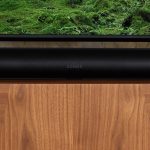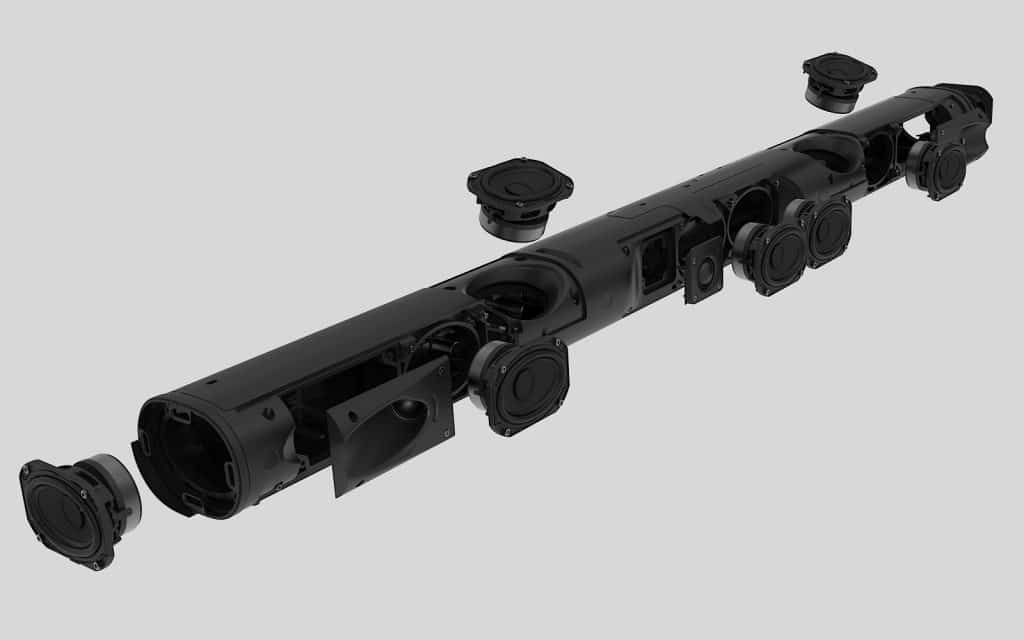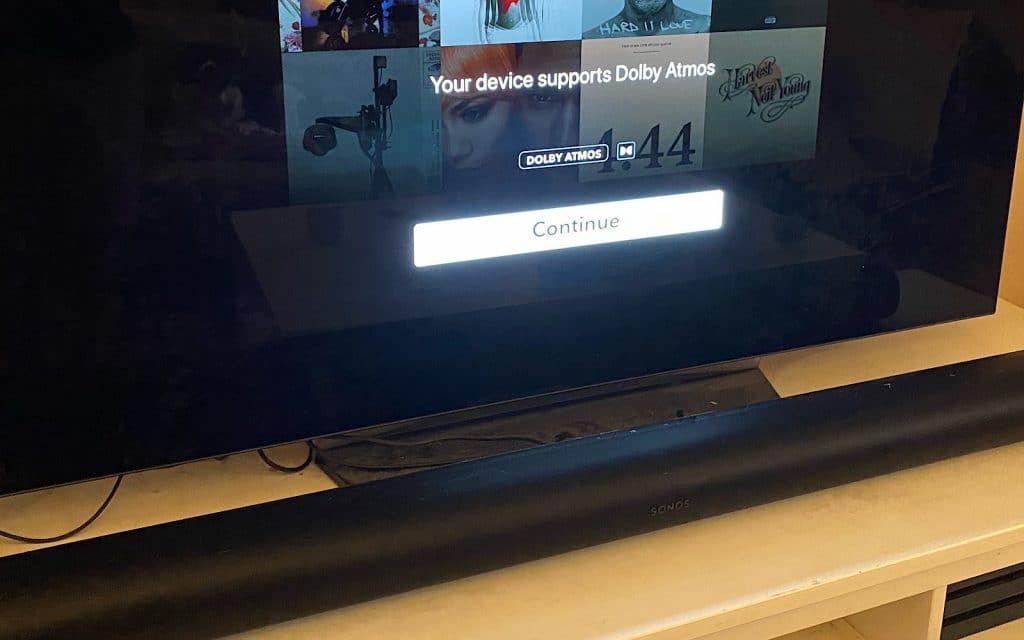Quick review
The good
The not-so-good
The next generation of the Sonos soundbar may well be one of the best for your home. Find out what makes the Sonos Arc special, and if it’s worth your time.
Music and movies are changing, and sound is becoming more dimensional. Surround sound gets us some of the way there, sure, but thank to 3D sound technologies, we can make sound do a little more.
By “more”, we mean a type of sound that can appear around you, popping near your head and making sound more dynamic and immersive. It’s not just the sound of an explosion behind you, but a crackle and sizzle and pop closer to your face. You can’t smell the singe nor feel the heat, but you can hear the sounds as they appear nearby.
That’s a type of surround we’re seeing more and more, as spatial 3D sound comes to life in speakers. You’ll find it in devices supporting both DTS:X and Dolby Atmos, though the latter of these is clearly the more popular and available of the two. You can find Dolby Atmos on 4K movies across iTunes and 4K Blu-ray Discs, not to mention other services, and provided you have a speaker system that supports Dolby Atmos, you can bring it all together under the one roof. Literally under the roof, because there’s a good chance an Atmos system will need that roof to bounce sound on.
In Sonos’ latest speaker, the company is using this technology to make movies and music sound more real, and more around you. Packing in 11 speakers and amps into a device that feels thinner, the Sonos Arc looks to be a soundbar you can grow with, and one that stands out. Made for movies and music, not to mention multiroom audio for across the house, the Sonos Arc isn’t just a new version of the Playbar, but new territory for Sonos altogether: it’s a Sonos that doesn’t just play sound, but gets you into it.
It could very well be the best Sonos speaker yet, but at $1399, is it worth the admission price?
Design and features
A little bit different from Sonos’ first soundbar, the Playbar, the Arc follows a different look entirely. While the Playbar offered a plastic design with a soft fuzzy grill that was somewhat reminiscent of older speakers, this new one is more modern, with a long plastic circular bar and grill dots all over. It might look a little like the portable Sonos Move, but it’s more of an elongated take on it, albeit thinner as it is.
It’s thinner than the previous Playbar, too, but clearly much longer, fitting what is basically the length of a 55 inch TV, and encasing quite a few speakers in that design. If you have a big TV, this clearly looks like it belongs in front or situated nearby, and signals how much speaker design has changed.
Inside, there are 11 drivers handled by 11 Class-D digital amplifiers, with the speaker make up delivered by eight elliptical woofers spread out over the front, the sides, and the top, while three custom silk-dome tweeters deal with sound at the front. The split can be a little complicated to visualise, but think of it as each of the front speakers for left, right, and centre is complemented by a tweeter for high sounds and dialogue.
Essentially, there’s a woofer and silk-dome tweeter for the left speaker, a woofer and silk-dome tweeter for the right, two woofers and one silk dome for the centre, while the side speakers at the tail end of each side feature a woofer each, too. Sitting on either side of the centre channel at the top, there’s an upward firing speaker with wave guard to keep the sound firing up, bouncing off the ceiling and around you. Technically, that’s a 5.0.2 system, capable of five channels in front, and two firing up, while the zero is the subwoofer, because there is none here, even if the system should be able to handle bassy sounds as it is.
It’s a complex setup, but only on the inside. On the outside, it’s basically just a long block of plastic and dots in either black or white, with the hardware inside, the Sonos name at front, a few LEDs that jump between white and green (when muted), plus three touch sensitive buttons for pause and play flanked by volume controllers, and then four far-field microphones to listen for your commands when you’re sitting across the living room.
The optical port on Sonos’ first soundbar has been replaced from the first model, though in comparison to the HDMI ARC (supporting of eARC, too) that it replaces, it’s positively old school. Fortunately, there’s an optical converter in the box if you want to use that. There’s also an infrared port, an Ethernet port, and WiFi, though these are also somewhat left over from the last version, the Playbar. They’re here, too, but microphones and touch sensitive buttons join the design and 3D speaker in separating the Sonos Arc from what it replaces, the Sonos Playbar, which is still a perfectly capable soundbar, but is just the old school. The Arc is the latest Sonos has to offer, though aspects are very reminiscent.
In-use

Sure, voice control is part of the package, so you can configure and use either Amazon Alexa or Google Assistant to tell the soundbar what to load.
Or you can use your phone and tablet with the Sonos S2 app, which is a little cleaner, yet still offers solid functionality for the Sonos ecosystem. Control your music this way and send services to the speaker, or just let the TV send the sound from the HDMI ARC port directly to it.
Depending on what controls your media, you might even be able to control the Sonos Arc using the remote for that. The Apple TV 4K is what we use, and thanks to the ARC HDMI connection — which the Sonos Arc relies on — the Apple TV remote works with the Sonos.
Regardless of how you control the system, one of the features you’ll want to play with is TruePlay, which has been updated in the Arc to account for spatial testing. If you’ve never played with Sonos TruePlay, the idea is to use a phone or tablet’s microphone to test sound and configure speakers for the unique acoustic environment that is the room you’ve set them up in. It’s a concept that still only works with iPhone or iPad speakers (so if you don’t have one, borrow a friend’s), and uses the on-board microphones to test sounds and map the room.
Once TruePlay has done its thing, the sound of the Sonos Arc becomes a little more dimensional, leading you into just what the speaker can do.
Performance
To get the most out of the Sonos Arc, you’ll want to play films and TV shows with a Dolby Atmos soundtrack. That’s one of the handful of 3D sound systems out there, though in the case of the Sonos Arc, it’s the only one you’ll want to think about, as the Arc doesn’t support other 3D sound formats, so no DTS:X here, which is probably completely fine since Atmos soundtracks are more plentiful, anyway.
Finding those Atmos compatible movies isn’t remarkably difficult, either, with numerous streaming services supporting the technology, not to mention 4K Ultra HD Blu-rays and iTunes releases often arriving with Atmos soundtracks.
When you find a movie or TV show with Atmos, you’ll get to hear the soundtrack with elements occupying an almost physical distance from your ears, thanks to those upward firing speakers. Much like they do on other Atmos systems, Sonos is using those to bounce sound on your ceiling and land the sounds near your head, essentially having the sound effects fall around you.
But it goes deeper than that, particularly if you decide to expand upon the Sonos Arc’s one soundbar.
The soundstage is pretty well spread in the Arc soundbar itself, offering wide dispersion of highs, mids, and lows, enough to make it feel like a big sound. Even though there’s a lack of a subwoofer, there’s more than enough bass here that the 5.0.2 of the Sonos Arc will make it feel as if you still have one you’re using.
If you decide to bring two other speakers for rear sound and make the experience more like a 7.0.2 — five at the front, two at the back, two firing up — you’ll find the bass and dimensionality increases even more. Remarkably, you can turn the volume up on your Sonos Arc system, and it doesn’t necessarily feel like you’re looking to deafen yourself, but rather that the sound is just more encompassing. It’s crazy, but it works.
The addition of two rear speakers wrenches even more out of the Sonos Arc, and provides quite an impact, with the surround improving the immersion, while the dimensionality delivered on Atmos making things more interesting.
It’s a more shimmering and enveloping sound on Disney’s Frozen II, while The Lion King‘s roar scene after its final fight can shake the room without a subwoofer, there’s just that much bass. The result is enough to get a stunned face on this reviewer’s two-year old daughter, as if the lions had suddenly materialised in our living room and were being held on screen by the magic of Disney+ and such.
There’s a strong and spatial result in big films such as Star Wars: The Last Jedi and John Wick 3, both during battles and each with excellent soundtracks. It’s a surreal experience, and one that rates up with the most expensive Atmos soundbar we’ve reviewed thus far, the $4K Sennheiser Ambeo.
That makes it solid for new movies, though older films with a standard Dolby surround channel do well here, too. Granted, you lose the dimensionality, and Sonos isn’t doing a conversion to Atmos, so there’s no virtualisation, either.
However the upward firing speakers don’t have to do that upward firing when there’s no Atmos sound, and instead add to the sound firing out and around, effectively filling your living room with more audio. Granted, we didn’t feel that the Sonos Arc ever completed the back channels operating solo the same way adding an extra pair of Sonos speakers does, but the result is certainly something you won’t scoff at. This thing really performs.
Supporting Dolby Atmos Music
You might look at the Arc and figure it’s simply for movie sound, and we could see why you’d think that. After all, Dolby Atmos is largely a movie soundtrack technology, and one that has been used in major films for over five years. Granted, Atmos releases typically sound best in a theatre, a place we’re visiting less and less these days, and if you want Atmos at home, you’ve typically needed a 4K TV or 4K media player with support for the Atmos soundstage.
We have those now, and they’re fairly commonplace, so definitely within reach of more people. Hell, more than one video streaming service supports Dolby Atmos, so you can definitely get your mitts and ears on movie material to flex an Atmos sound system.
But what about music: is there a way to get the 3D spatial sound firing in your favourite tracks?
To put it simply, yes. Yes there is.
Early in our review period of the Sonos Arc, we started fiddling with Dolby Atmos Music, a concept you can find in Australia on Tidal’s premium HiFi service. In the US, Dolby Atmos Music is also on an Amazon Music service we don’t get locally, but from Australia, it’s Tidal only for Dolby Atmos Music.
Testing it in the early stages, it was pretty clear Tidal HiFi was conveying a pretty spatial sound in Dolby Atmos tracks, even if Sonos wasn’t clear if it was supported. We pushed Sonos’ local PR plenty of times to check, and eventually, we had a confirmation:
Sonos owners can get a preview of the Dolby Atmos Music experience with Arc when listening to TIDAL HiFi through compatible TVs supported streaming devices.
Our experience showed it working through the Sonos S2 app, but the real confirmation came through the recently released Tidal app for Apple TV, which not only delivered the same Dolby Atmos stream through the Apple TV 4K, but also provides confirmation in the log information for the Sonos Arc.
Most of this is just a technical thing, mind you. It’s great to know Sonos supports Dolby Atmos for music, but what it sounds like depends entirely on how the mix was handled.
If the engineers made a fairly basic job of upmixing what is normally two channel sound into the spatial approach that Dolby Atmos delivers, it can sound dimensional, but only barely. Much of the rock and some of the jazz we tested on Dolby Atmos exhibited this, and was hardly game changing.
Not all tracks were like this, though. In some tracks, the engineers clearly had a blast placing sound elements in the mix and generating a really distinctive 3D sound, well then you get something else entirely. Take Prince’s “When Doves Cry”, which becomes a spatial crazy immersive delivery of percussion and sound that feels like you’re literally being encompassed by one of the classics in Prince’s repertoire. Or consider the Lady Gaga and Bradley Cooper duet “Shallow” from the film A Star Is Born, which clearly has seen the Atmos treatment from its movie release, and exhibits an almost binaural quality where it feels like you’re on stage with the two actors and singers, hearing the band and audience.
It’s a rendition of music that is hard to turn away from, and one that may change how you listen to your music, provided more of it comes out. Once you go Atmos, you might never go back-mos.
 Value
Value
But the price could stop you in your tracks, because at $1399, the Sonos Arc is the most expensive Sonos speaker yet, and a fairly pricey soundbar at that.
We feel it’s worth stressing the point that Atmos-enabled soundbars aren’t typically cheap at the best of times, and you can usually expect to pay between a grand and four grand for the privilege. Of course, the highest price on these goes to the some of the more impressive technology you’ll find, with Sennheiser’s Ambeo filling this gap, but that’s a beast of a thing.
The Sonos Arc is something else. Long and thin, it’s a more elegant take on an Atmos soundbar, and one that houses a surprising amount of power and technology.
At $400 more than the original Playbar from seven years ago, it’s the new take on that product, which by the way is still going strong. Both are engineered for five channel audio, but the Arc gives you a little more, which in the world of modern entertainment is worth waking up and taking notice.
Granted, there’s no subwoofer included, a fact you’ll only realise from the physical setup, because the bass output from the Arc is monstrous enough to convince you otherwise.
At almost a thousand more than the Beam, the Arc argument becomes a little more complicated. When we reviewed it back in 2018, we found the $599 Sonos Beam to be enough soundbar for anyone starting out and who wanted both better sound for their TV and a multiroom capable speaker, and it’s still very much that. But if you have a big room or a desire to get dimensional audio (or both), you need something else.
At $599, the Beam is an excellent starting point for capable TV sound at home. At $1399, the Arc one-ups that to deliver even more, and is ideal for people who are thinking big, and buying with the future of their home entertainment system in mind.
If you were already going to spend the grand on the now superseded Playbar because the output volume was bigger, spending a little more on the Arc is totally justified, while the performance and features you get in the voice assistant and 3D sound more than make up for the increased cost.
What needs work?
We can justify the price on a soundbar that we love the performance of. And we really love the performance here. The Arc is a stellar soundbar with so much to fall in love with.
So what’s wrong? Surprisingly not much. Who knew that in the lead up of seven years to build the next generation of soundbar that Sonos would iron out nearly every possible crinkle and crease that needed ironing out. It’s crazy, but Sonos has nearly perfected it.
If not for one thing: rear sound.
The Sonos Arc is technically a 5.0.2 speaker, so let’s again break up those numbers: five stands for surround speaker channels, zero is for how many subwoofers there are (none), and the last two signifies the upward firing speakers needed for the 3D sound in Dolby Atmos.
Because of the soundbar’s front-only design, however, the five channels are just that – at the front. That means you’re somewhat reliant on a 3D sound to achieve a rear speaker soundtrack using the Arc alone, and it just doesn’t work as well that way. You will get strong sound, and there’s an element of dimensionality when using an Atmos soundtrack, but the full rear sound isn’t really there, at least not until you add actual rear speakers.
Mind you, that’s something that can be done, and quite easily. Because the Sonos Arc falls under the Sonos multiroom system, it supports rear channel completion from stereo speakers in its assortment of supported products, including the big Sonos Five and second-gen Play:5, the smaller Sonos One and Play:1, and even Ikea’s assortment of less expensive Sonos-compatible Symfonisk speakers.
You’ll need two for that stereo pairing, but it means if you want that rear channel accounted for, you have plenty of options, they’re just not physically in the Arc soundbar itself. That might mean spending a little more for those speakers, or it might be that you relocate a couple of Sonos speakers you weren’t using. One thing’s for sure: the rear channel on the Arc certainly sounds better when you have speakers doing the heavy lifting for it.
Final thoughts (TLDR)
At its release, the Sonos Arc is one of those gadgets that just feels like it’s an almost perfect delivery, and comes across rather a lot like something high-end from Apple: it’s been built to do something so well, good luck finding problems with it. It’s a premium soundbar with premium quality, and while that “premium” can feel expensive, the result is clearly a premium product that really, truly delivers.
By itself, the Sonos Arc is a fantastic front-facing soundbar offering oodles of audio and sizeable sound. The soundstage feels bigger than it should — certainly bigger than the speaker itself — and the result is something that brings your entertainment to life. Truly, utterly, be it music or movies or TV or what-have-you. And with all of that other Sonos goodness, the Arc stands out against other soundbars. It’s big, dynamic, and can connect music around your home.
If you do connect those speakers up, the Sonos Arc becomes something even greater, like this big robot that is powerful by itself, but suddenly is just that much more of a force to be reckoned with when joined by its friends. Two rear speakers with the Sonos Arc can turn your living room into a veritable home theatre, with so much sound, you literally won’t know what to do with yourself, beyond annoying the neighbours. We didn’t add the Sonos Sub, but if you did, we imagine your sound would practically verge on being unstoppable.
Simply put, this thing is fantastic, and can be summed up quite easily, too. The Arc is Sonos’ best speaker, and a damn fine soundbar, too. Highly recommended. Ridiculously so.

















